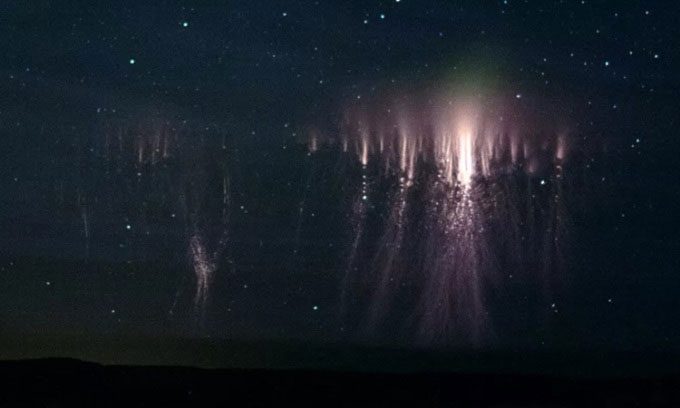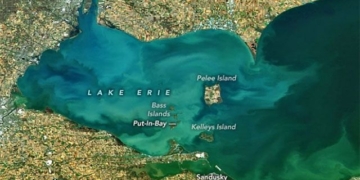Researchers have discovered new details about a rare phenomenon that creates a “green ghost” in the Earth’s mesosphere.
Findings published on December 12 in the journal Nature explain the physical processes that form the ghost and why it emits a green glow. This phenomenon, known as the mesospheric ghost, consists of faint green halos that appear infrequently and last for several hundred milliseconds when a special type of lightning called sprite occurs.

Green ghost above a sprite on June 23, 2014, in western Oklahoma. (Photo: Thomas Ashcraft).
Sprites are spectacular large electrical discharges that appear as orange-red flashes. They are a type of lightning that lasts for a short duration, occurring above the altitude of regular lightning, known as transient luminous events (TLE). The most common TLEs include sprites and various other atmospheric phenomena such as halos, elves, blue jets, and gigantic jets. Some sprites, like jellyfish sprites, have animal-like shapes.
TLEs were first observed in 1989. Since then, photographers around the world have spent many nights hunting and sharing images of these beautiful flashes. The mesospheric ghost is quite rare, occurring above sprites and also classified as a TLE. “Like all members of the category, the green ghost develops through complex interactions between thunderstorms and the Earth’s atmosphere,” said María Passas Varo, co-author of the study at the Solar System Department of the Andalusian Institute of Astrophysics in Spain. “They are extremely rare, with only 1 in 100 sprites accompanied by a green ghost.”
The green ghost was first discovered in 2019 by scientist Hank Schyma. In May of that year, Schyma filmed a storm with sprites in Oklahoma and observed a green halo appearing above, lasting for several milliseconds. Following Schyma’s observation, the primary hypothesis explaining the green ghost phenomenon suggests that it is the result of excited oxygen atoms emitting light in the green spectrum.
After viewing Schyma’s footage, Varo and colleagues began a research project to understand the nature of the green ghost. They employed a spectrometer, a light-detecting device for recording color components, providing scientists with data on what generates it. While excited oxygen atoms are believed to be the cause of the green color, the material associated with this process has not yet been identified due to a lack of spectral observations.
In June 2019, Varo and her team initiated a spectral observation campaign in Castellgalí, located near the northeastern coastal region of Spain in Barcelona province. They measured spectra at wavelengths visible to the human eye, mainly in the green light range. The scientists collected over 2,000 images and videos of TLEs. However, observing the green ghost remained extremely challenging with the equipment used by the research team.
To capture the rare ghost, the spectrometer had to be directed towards altitudes where they were most likely to appear. Over nearly four years of filming, the research team successfully captured only 42 images from above the sprites. They observed the green ghost on one occasion only. This successful observation occurred on September 21, 2019, when they detected jellyfish sprites in a thunderstorm above the Mediterranean Sea. The spectral data they collected from the sprites indicated the presence of the green ghost above them.
Although they did not capture any color photographs of the ghost, the research team knew they had recorded a case because the light emitted from the phenomenon was predominantly observed in the green spectrum. Additionally, the phenomenon lasted over 500 milliseconds, whereas sprites only last about 20 milliseconds.
Upon analyzing the data, scientists found weak but definitive traces of excited oxygen atoms, confirming previous hypotheses. They also discovered other elements in the atmosphere, including iron, nickel, and nitrogen atoms, contributing to the green color. The research team hopes to detect more of these phenomena in the future.


















































